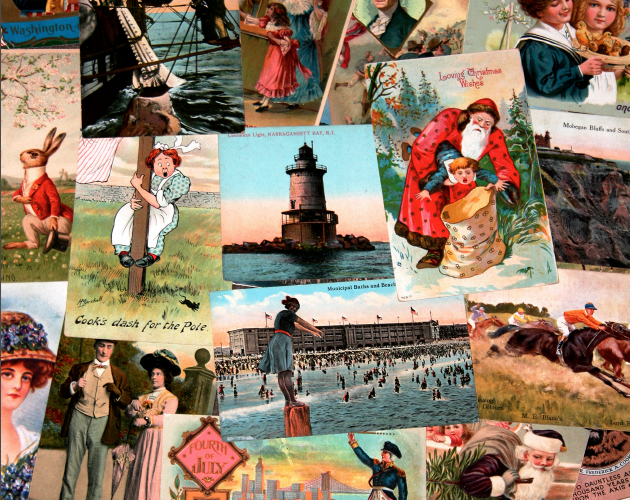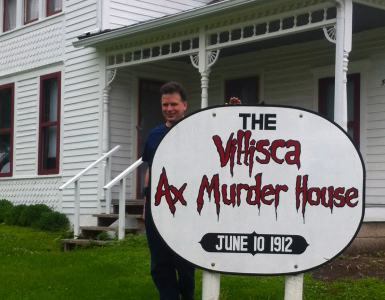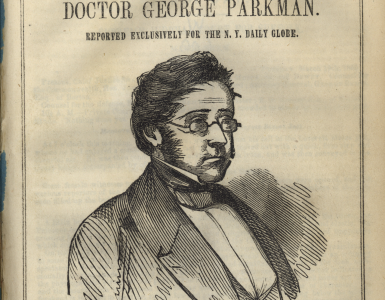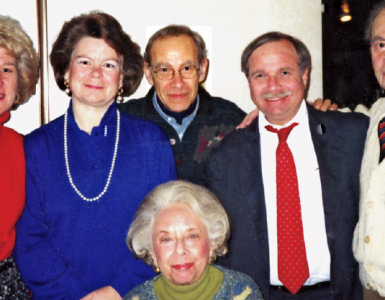by Michael Brimbau
First published in February/March, 2007, Volume 4, Issue 1, The Hatchet: Journal of Lizzie Borden Studies.
Postcard collecting, or deltiology as it is known in the trade, is the universal hobby. It is one of the world’s most popular pastimes, surpassed only by stamp and coin collecting.
Although the steep incline of the Bourne Bridge was no challenge to the old Buick, its driver had to squint to see the road clearly through the torrential downpour. It appeared more like we were passing through a car wash than crossing the Bourne Bridge over the Cape Cod Canal. The raindrops were the size of marbles. The whining noise emitted by the overworked wiper motor competed with the pelting clatter produced by the enormous drops that rapped the car’s hood and roof. I sat in the back seat gazing through the foggy deluge towards the old railroad bridge and the entrance to Buzzards Bay—or at least to where it should have been. Below, on the blue murky flat waters, pleasure craft appeared through the gray mist only to vanish again like a mirage on the distant dim horizon.
Donald Winland, proprietor of the Bookmark Bookstore in Newport, Rhode Island, sat in the front passenger seat. Driving was Russell DeSimone. Russell was twice president of the John Russell Bartlett Society Book Club and is an historian on broadsides and billheads from Rhode Island. He is author of two books: The Broadsides of the Dorr Rebellion and A Survey of the 19th Century Rhode Island Billheads.
As a new collector, I was excited to be asked to tag along on their annual spring ramblings through Cape Cod’s many antiquarian bookstores. I felt fortunate to have two knowledgeable book lovers take me under their wings and teach me all they knew.
A rainy weekend is an ideal occasion for book exploration. After a long day of combing bookstores all over Cape Cod—such institutions as Parnassus, Titcombs, and Lord Randall to name a few—I sat rummaging through my shopping bag full of new literary purchases. With unfettered enthusiasm, I rediscovered each title as if for the first time, tenderly stacking them on the seat beside me where we become good friends.
“You have room to store all those books?” asked Russ.
Don turned in his seat laughing. “Sure he does . . . and what room we don’t have we make, right Mike?”
With a gleam in my eye, I smiled and nodded in agreement.
“You should consider collecting paper; it takes up much less room,” declared Russ. He wiped the steamy mist from the windshield with a coffee-stained napkin. Like a child with building blocks, I continued to pile the books beside me. The mound became higher and in peril of sliding onto the floor.
“Paper?” I inquired.
“Yea, like the napkin Russ is using,” Don grinned. “Once he becomes famous that very napkin will take on new value as ephemera.” He pretended to write with his finger in mid air, “As used by historian Russell DeSimone, in the summer rainstorm of 1989.”
Russ threw the damp napkin into Don’s lap. “Hang onto it then, it will make you rich one day.”
Both men laughed.
Still pulling books from the bag, I ignored their jousting, began a second stack, and continued my inquiry. “Just what is considered ephemera?”
Russ turned his head, all the time keeping his eyes on the road. “Broadsides, billheads, letters and such. Lots of value in ephemera and it takes up very little room. You can house an entire collection of thousands of dollars in a simple desk drawer.”
“I could never get into collecting paper,” argued Don. “But I must admit to being guilty of collecting stamps and postcards.” He lifted his solitary acquisition, a large coffee table book on Japanese swords, and heralded, “Books! Books are my game.”
“How about postcards, Russ?”
“Anything in the form of paper—pamphlets, cardboard, even a baseball game ticket, used or unused—falls under the realm of ephemera.”
“I never thought of postcards as ephemera,” I confessed.
“Sure. Postcards, greeting cards, trade cards, anything from a pictorial tomato ad on the side of an old pine vegetable crate to an exceptionally rare movie poster—all are ephemera.”
“I collect matchbooks from restaurants,” I declared in embarrassment.
“Great, I collect cigar bands,” countered Russell. “All ephemera.”
That day was the start of a well-earned lesson in all things ephemera. Although I found it a pursuit well worth exploring, Donald affectionately declared it “a paper trap.” While ephemera was not to become a serious area of collecting for me, one tiny aspect of it did—Postcards.
Becoming a Deltiologist
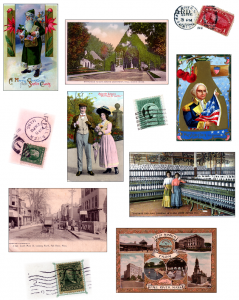 My initial pursuit was not in collecting postcards but in finding photos or images of early 20th century Fall River to supplement my book collection. I attended book and paper shows, and visited antique shops in search of both ordinary and unique Fall River postcards. My collection expanded with each passing year and soon I had amassed what I considered to be a good beginning, full of the common cards, but yet to contain the truly rare and expensive images. Through this search I became distracted, but somewhat fascinated, by many other topics. I soon found that fondness for the ocean had me exploring postcards of lighthouses, seascapes, passenger liners and whaling. Over time, my interest sprouted to include Presidents, Madeira, humor and Santa Claus. I was caught up in the “paper trap,” and relishing it.
My initial pursuit was not in collecting postcards but in finding photos or images of early 20th century Fall River to supplement my book collection. I attended book and paper shows, and visited antique shops in search of both ordinary and unique Fall River postcards. My collection expanded with each passing year and soon I had amassed what I considered to be a good beginning, full of the common cards, but yet to contain the truly rare and expensive images. Through this search I became distracted, but somewhat fascinated, by many other topics. I soon found that fondness for the ocean had me exploring postcards of lighthouses, seascapes, passenger liners and whaling. Over time, my interest sprouted to include Presidents, Madeira, humor and Santa Claus. I was caught up in the “paper trap,” and relishing it.
Postcard collecting, or deltiology as it is known in the trade, is the universal hobby. It is one of the world’s most popular pastimes, surpassed only by stamp and coin collecting. Whether you are 8 or 80, with a meager savings of a few dollars or happily endowed with a budget in the thousands, postcard collecting holds something affordable and of interest for all. Many with interests in other fields, such as books, sports or travel, have stumbled upon a postcard or two and become totally absorbed.
Vintage postcards in almost any subject may be purchased for as little as fifty cents or thousands of dollars. Several examples were recently listed on eBay, including one dated 1948 and signed by Babe Ruth, and another signed by three of the Beatles, dated 1967. The Babe Ruth card was selling for $3750 and the latter displayed a $5600 asking price. At the other end of the monetary scale is a vintage postcard of a William Penn monument dated 1912, a bargain for 50 cents. Also listed was a nice circa 1910 divided back postcard of St Mary’s Church in Fall River. Saint Mary’s stands a half block away from the Borden house on Second Street—the asking price tag was $4.00. Although I have three cards of the same church, this one is from a different angle so it is difficult to resist.
Without promoting eBay, I feel they are hard to ignore as an excellent source for postcards in quantity and variety. The downside of buying over the net is the postal rates, which add to the cost but not the worth of the purchase. Purchasing more than one postcard from the same dealer or seller may offset this. Whether it is a postcard about sports, views, pretty girls or politics, you will find countless private dealers and collectors with offerings on your PC without ever leaving the house.
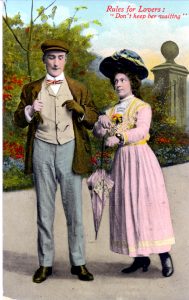 Unfortunately, for some of us Hatchet readers with an exclusive interest in the Borden murders, there are few “vintage postcards” available to collectors. In my travels, the oldest cards I have uncovered on the crime are two similar unexciting chrome photos displaying the front of the Second Street house. These appeared to have been printed in the 1970s. Six years later another card displaying the house, with a cameo of Lizzie in the upper left hand corner, appeared. One card we must not forget is the Rick Geary postcard—a drawing of Andrew Borden lying on the horsehair couch—really a reincarnation of his book cover of The Borden Tragedy. Conservative sentiment in the greater part of the 20th century stifled any commercial promotion of the Borden murders. In many ways Fall River remained in mourning well into the 1950s and 60s over the murders. It would be shameful to bring any attention to a case perceived as scandalous. To market murder and identify with the crime was nothing short of disgraceful. Even modern day trading cards, such as the “True Crime Series” issued in the early 1990s (which included a card on Lizzie Borden), stirred enormous controversy and protest all over the country. Though few postcards on the Borden murders are available, hundreds of cards with views of Lizzie’s hometown are easily obtained. Some good examples of postcards with a Lizzie connection are views of the Central Congregational Church and A. J. Borden Building on the corner of S. Main Street and Anawan.
Unfortunately, for some of us Hatchet readers with an exclusive interest in the Borden murders, there are few “vintage postcards” available to collectors. In my travels, the oldest cards I have uncovered on the crime are two similar unexciting chrome photos displaying the front of the Second Street house. These appeared to have been printed in the 1970s. Six years later another card displaying the house, with a cameo of Lizzie in the upper left hand corner, appeared. One card we must not forget is the Rick Geary postcard—a drawing of Andrew Borden lying on the horsehair couch—really a reincarnation of his book cover of The Borden Tragedy. Conservative sentiment in the greater part of the 20th century stifled any commercial promotion of the Borden murders. In many ways Fall River remained in mourning well into the 1950s and 60s over the murders. It would be shameful to bring any attention to a case perceived as scandalous. To market murder and identify with the crime was nothing short of disgraceful. Even modern day trading cards, such as the “True Crime Series” issued in the early 1990s (which included a card on Lizzie Borden), stirred enormous controversy and protest all over the country. Though few postcards on the Borden murders are available, hundreds of cards with views of Lizzie’s hometown are easily obtained. Some good examples of postcards with a Lizzie connection are views of the Central Congregational Church and A. J. Borden Building on the corner of S. Main Street and Anawan.
For those interested in becoming a deltiologist, collecting postcards is made easier by engaging in a short study of the history, descriptions and changes that have occurred in over a hundred years. This will help you narrow and focus on a subject, topic or theme. The more informed you become the easier it is to settle on a specific subject or era. You may already have a topic and not even realize it. For me it was early historical views of Fall River, such as mill buildings, theaters, schools, street scenes, and an array of historical images that no longer exist in life.
The secret to becoming a savvy collector is to narrow the field of interest. Collect only one topic until you have collected most of the popular and scarce cards on your topic. You do not need to collect every card you find in your field to complete a collection. Only you can declare your collection complete. Once you do you are ready to wander through the hundreds of other topics and billions of cards available.
Let us say your topic is lighthouses. You may find thousands of cards of lighthouses from all over the world. Do not be overwhelmed, but rather, focus and condense. Do not buy every card you come across. You may end up with a large investment into cards that just do not fit into your collection. Curb your interest to lighthouses in the United States. Then narrow it down further to lighthouses on the east or west coast, or perhaps the Great Lakes. Again, do not stop there. Modify further to lighthouses of New England or Michigan. If your interests stray, do not let it go too far at the beginning—focus on a tight field. Just when you think you have found every card printed in your field, new and exciting cards will make their presence known.
A Lesson in Postcard History
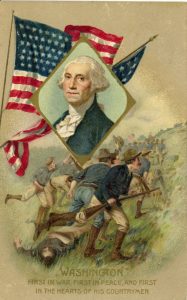 The birth of the postcard had its roots in Europe in 1869, during what is known as the Pioneer Era of postcards. The first postal cards were introduced by Dr. Emanuel Herrmann and accepted by the Hungarian government, and soon caught on in England and Germany. The first non-postal postcards, those printed privately, where a postage stamp had to be affixed to the cards themselves, were introduced in Austria in 1869. The first commercial card containing topical interest was French, and published in 1889. It displayed the Eiffel Tower and was the earliest form of the modern picture postcard.
The birth of the postcard had its roots in Europe in 1869, during what is known as the Pioneer Era of postcards. The first postal cards were introduced by Dr. Emanuel Herrmann and accepted by the Hungarian government, and soon caught on in England and Germany. The first non-postal postcards, those printed privately, where a postage stamp had to be affixed to the cards themselves, were introduced in Austria in 1869. The first commercial card containing topical interest was French, and published in 1889. It displayed the Eiffel Tower and was the earliest form of the modern picture postcard.
In the United States, the first view printed postcard was issued for sale as a souvenir in Chicago in 1893 at the Columbian Exposition. At that time the U.S. government was the only one allowed to issue a one-cent postal card in the United States. Privately printed postal cards could only be mailed using the two-cent postal letter rate. Finally, in 1898, Congress allowed the private sector to publish cards that could be mailed for one cent. Though the law changed, the government reserved the right to be the only one to call government issued cards “post cards.” All privately issued cards had to have the words “Private Mailing Card” printed on the card. However, it was soon after, in 1901, that the government allowed the declaration “Private Mailing Card” to be removed. Up until then it held the exclusive right to use the term “post card” (postcard). This action, and a drop in private postal fees, along with the advent of improvements in color technology, launched a postcard craze across the country.
When browsing through vintage postcards you will notice that there are numerous designs. These format modifications were made over a long period of time. The government regulated some changes while others can be contributed to variations in trends and style.
The first postcards were printed with “Undivided Backs.” This era of postcards lasted until 1907. The government did not permit any writing on the back of the card—only the address was allowed. You will find many cards from this era where someone wrote a message right across the face of the card. They were not reckless or mad, just obeying the law. Some cards from this period had a small space or border along the bottom, which allowed a limited amount of writing on the face of the postcard.
By 1905, many European countries were allowing citizens to write on the address side of the card. By 1907, the U.S. followed suit, and thus began the “Divided Back Era” that lasted up until 1915.
This period from 1907 to 1915 was known as the “Golden Age” of postcards. This is my favorite period and makes up the bulk of the cards I collect. Marvelous technological advances were made in printing and color during this period, most of it in Europe. The best lithography in the world during the Golden Age came out of Germany where the majority of printers of postcards existed. Unfortunately, WWI brought a halt to the availability of cards and the trade took a serious blow. Lacking the printing and color technology postcard quality suffered as the United States and England tried to fill the void. Making matters worse was the more common use of the folding greeting card, which was growing in popularity, along with the acceptance of the telephone. After the war, most of Germany’s publishing houses were gone. Along with the advent of new American tax tariffs, German exports of postcards became financially prohibitive. Germany’s postcard industry never recovered.
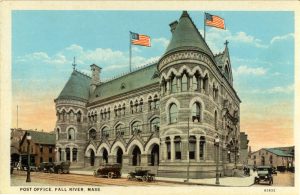
Between 1916 and 1930, we see the dominance of the “White Border Card” (sometimes called the “Early Modern Era”). The white border that framed the image was not the only change. Printing quality was nowhere near the superior cards of previous years.
In time, with advances in American proficiency in printing and color, came the birth of the “Linen Card Era” or rag card. This process had its inception around 1930 and remained popular up until the middle 1940s. The print method used not only proved to be a great improvement over previous years but even the paper used, being a linen textured stock, was superior. These rag cards mostly replaced the white border cards and gave the postcard industry a new boost. However, once again, postcard commerce was seriously interrupted—this time by WWII.
Woven into the end of this era and coming on strong in the late nineteen forties, the last big change in postcard production arrived, namely the “Photochrome Card.” Chrome cards are photographic cards with a shiny surface, like modern day photographs. Eastman Kodak pioneered this process. The term “Chrome” is commonly used to describe cards printed in the Kodakchrome process.
Search and Discovery
Now that we know how to distinguish the differences between postcards, we are now well on our way to choosing a topic or field of study. The fields are almost countless, with the most popular being the View Postcard. Most view cards are historical and depict images of cities and towns, including buildings, monuments, schools, churches, bridges, theaters—both local and foreign, still standing or long gone. Other topics include greeting and holiday cards, historical and political, artistic and real photo cards. This is a minuscule list of the diverse subjects you can collect.
Postcards have taken a back seat to most methods of communication. Today most are purchased as souvenirs, never to wear a postal stamp.
 When I was a child, I could not walk into a pharmacy, department store, or corner variety store without discovering one or two circular wire postcard racks. Most were placed close to the register or the front door, displaying postcards from all over town and state. Clutching our candy or comic book, we were usually rudely escorted out the door after spinning the postcard racks round and round after glossy postcards went hurling in the air.
When I was a child, I could not walk into a pharmacy, department store, or corner variety store without discovering one or two circular wire postcard racks. Most were placed close to the register or the front door, displaying postcards from all over town and state. Clutching our candy or comic book, we were usually rudely escorted out the door after spinning the postcard racks round and round after glossy postcards went hurling in the air.
At the end of this narrative is a list of topics and themes. Once you have chosen one, visit your local antique or antiquarian bookshop and inquire if they sell postcards. You may not find them on display. Many such shops do not retail in postcards and may have them stored away in a box to consign to dealers who do. He or she may offer you the entire box for a bargain. Another good source may be the local library where books on the subject may be found. Inquire of the staff if there is a postcard club in your area. Once a group or society is discovered, members will place you on the road to the best locations to find postcards in your field. Along with making new friends, you may find other collectors who have duplicate cards for sale in your field.
Today the best place to begin exploring the diverse world of postcard collecting is the Internet. A casual peek of the web will uncover a myriad of sellers—experienced professionals and knowledgeable novices—giving valuable advice and worthwhile tips, from collecting postcards to the care and preservation of your cherished collection.
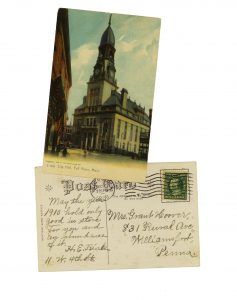 Most of the cards in my collection are from the Golden Age. Many cards cost less than two dollars; most are easily available and some downright common. Large cities published many more cards than small towns, so more of them are available and therefore inexpensive. Many are of the same scene offered by different publishers, or presented from diverse angles. Many cards are of the same image scattered over a hundred year period. Most are miniature historical records, petite works of art. As with anything collectable, the more scarce the postcard, the more demand, thus the more expensive. Nevertheless, postcards are still a lot less expensive than most other fields such as stamps, coins or books.
Most of the cards in my collection are from the Golden Age. Many cards cost less than two dollars; most are easily available and some downright common. Large cities published many more cards than small towns, so more of them are available and therefore inexpensive. Many are of the same scene offered by different publishers, or presented from diverse angles. Many cards are of the same image scattered over a hundred year period. Most are miniature historical records, petite works of art. As with anything collectable, the more scarce the postcard, the more demand, thus the more expensive. Nevertheless, postcards are still a lot less expensive than most other fields such as stamps, coins or books.
The most expensive postcards in my collection are a set of 16 cards, all taken inside the textile mills of Fall River. They are a visual chronicle, illustrating the drudgery of mill life during the late 19th and early 20th centuries. Market value for the set is $350 to $400. Other cards of significance of Lizzie Borden’s Fall River are those displaying the rollercoaster at Sandy Beach in the south end of the city. These should bring between $50 and $75 dollars, or more. Along with the mill cards these make a praiseworthy cornerstone propping up any Fall River postcard collection.
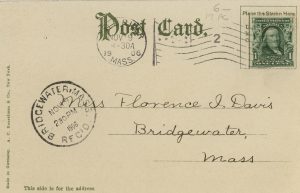
There are only a handful, at best, of expensive or rare postcards in any category when compared to the billions of cards printed and available. These topics include cards on travel and exploration, politics, animals, flowers, railway, ships, humor and leisure, etc. Some of the special ones are embossed, others enhanced when held to light. Many are real photographs and highly collectable, thus more expensive. Still others are signed or signature cards by famous artists of the day, including Howard Chandler Christy, Charles Dana Gibson, Harrison Fisher and a host of others. (Signatures are printed on the bottom below the image and are not autographed.) Many of these postcards portrayed “pretty ladies” flaunting large flowery gaudy hats and cheerful genial smiles. If in your search you find your money burning a hole in your pocket, look into collecting Holiday postcards. These cards include Christmas, Halloween, Thanksgiving, New Years and more. My favorite are the Santa Claus cards published in Europe. These celebrate Santa dressed in blue, black, green, violet, white, brown, and a host of other colored robes and jackets, including countless variations and patterns of red. Replicas of cards issued in Victorian times may be less than a dollar while vintage Victorian cards sell regularly in the hundreds.
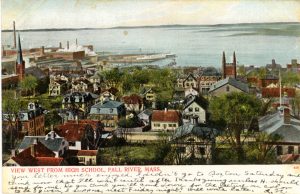
When purchasing a card, make sure it is in very good to fine condition. Flawless cards bring greater value and are much more desirable and easier to sell. Try to avoid cards with chipped or bent corners, serious scuffing, creases, water staining, or tears. Of course the more rare the card the more defects you may be willing to accept. Otherwise, you may never own that elusive card you have been searching for so long. In time, you will be sure to find a better one. Upgrade and sell the inferior copy.
Care and Sources
Much of the care given to postcards is measured by common sense. Three of the most damaging enemies of postcards, or with any paper collectable, are acid, sunlight and moisture. To retain their value, never place postcards in an ordinary photograph album. Many of these were made with PVC plastics that damage paper. On the other hand, don’t store your collection loose in a desk drawer where they may become marred or bent. To instruct that you should never use any sort of adhesive on a postcard would be to insult your intelligence. Special acrylic postcard sleeves of archival quality are sold which are acid free and will hold four cards each. These can in turn be housed in a conventional loose sleeve folder. Be careful when inserting the postcard into a sleeve not to bend over the corners.
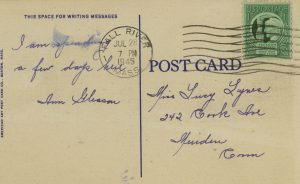
As with any collectable, “condition” is everything. My favorite method of storing cards is in individual plastic sleeves. These are sold in an assortment of weights. Buy a quality hefty sleeve, store your collection in a card box, and keep it in a cool dry location. The benefit of this storage system is that you can bring the box to a table and pass cards around to a group of friends or collectors. Card boxes also allow you to access one card at a time for view without removing them from a folder sleeve where they may become damaged.
Framing or displaying postcards on the wall can be fun. Have them professionally framed if they are very rare. This way you can remove the card without damage if you wish to sell it. Mount them on a wall away from sunlight or in a dark area. Even regular household incandescent lighting can fade a card in good time.
Though I have not seen Russell DeSimone in many years, I understand that he still collects ephemera. Donald Winland has collected over 800 Newport, R.I. postcards. Today he retains a wonderful Santa Claus and Halloween postcard collection. Don and I still do our power treks across New England in search of books, where I always discover postcards to enhance my collection. I recently expressed my interest in purchasing his Santa Claus postcard collection. To this inquiry I received no response, just a docile smirk not much different of one wallowing in the joys of the postcard “paper trap.”
Postcard Language
Arcade Cards—Printed as souvenirs and usually sold in penny arcade vending machines. Illustrations may be people, animals, or just pinup art. These were printed with plain backs.
Archival—Any material used for the preservation of precious documents, manuscripts, photos and the like, to protect against soiling, acid and other harmful environmental elements.
Artist Signed—A postcard signed by the artist or illustrator. It is not an autograph signature but a printed byline on the card usually below the illustration identifying the artist.
Chrome—A postcard displaying a shiny surface similar to modern-day photographs and introduced in 1939. The term chrome was coined by Eastman Kodak and its Kodakchrome process.
Condition—Self-explanatory. Descriptions used are: Mint, Fine, Excellent, Pristine, Very good, Good, Fair, Poor.
Copper Windows—Usually postcards of buildings where the windows display a metallic copper paint added to the windows to simulate light.
Deltiology—The study or collection of postcards. First used in the United States. A deltiologist is a person who collects postcards.
Die Cut—Any paper or card that is cut into the shape of an image or illustration.
Divided Back—These cards had a line dividing the back. One half was for the mailing address, the other for the message.
Embossed—A card where the design or illustration is raised above the surface apart from its background. Many have decorative and laced edges.
Ephemera—Any item with printing or writing such as letters, billheads, checks and the like, meant to be discarded after its intended use. The field is endless and includes postcards, posters, tickets, trade cards and photos, to name a few.
Foxing—Brown staining or spots that develops over time to a paper’s surface. Believed to be a chemical reaction between the acids in the paper and moisture in the air.
Gelatin—Postcard with a varnish type of coating producing a shiny or glossy finish. Over time most of these surfaces shatter or crack.
Government Postal—Government issued postcard, most before 1898, with a preprinted stamp on the back.
Hold to Light Postcard—Generally a card containing “cut-outs” on the top layer of the postcard revealing another colored layer beneath when held to a light. Sometimes confused with transparency cards.
Linen—This is a card with a textured surface resembling fabric. Very popular in the 1930s and 1940s.
Mechanical—Postcards that have moving parts. These may include pull-tabs, wheels or a flap that lifts to reveal another image beneath.
Miniature—These cards were about half the size of a normal postcard and were printed as a novelty during the Golden Age.
Novelty—These may include mechanical cards or cards with items attached to them such as ribbons, fur, medallions, silk, etc.
Oilette—A term used to describe a particular style of card made to look like an oil painting with noticeable brush strokes.
PVC—Poly Vinyl Chloride used in the making of plastic sleeves. PVC is damaging to paper in time and should be avoided.
Pioneers—Postcards issued before the Act of Congress in 1898.
Private Postal—Postcards produced by private publishers apart from those issued by the U.S. government. When first issued these usually needed a two-cent stamp compared to the government one-stamp cards.
Real Photos—Actual photograph printed on photograph paper with a preprinted postcard back. Real photo cards are more sought after than commercially printed postcards. Many are real photos and one of a kind.
Sepia—A photographic image that appears in shades of brown by using the pigment found in the sepia cuttlefish.
Topics—Postcards that are not views. Animals, pretty ladies, sports—these are examples of topics.
Tradecards—Advertisement cards issued before 1900. These were given away by shopkeepers to promote their business.
Transparency—Similar to a “Hold to Light” postcard but without cutouts. Made from many layers of thin paper in such a way that when held to the light a change in the image is achieved.
Undivided Back—A postcard where the entire back is used for the address and where no other writing was allowed.
View Cards—Postcards that show cities including buildings, parks, main streets, train and bus depots, theaters, bridges, roads, statues, beaches, etc. This is the most collectable type of postcard.

Grading Condition Terminology
Grading postcards may differ between dealers and collectors. Terminology used in describing the condition of postcards is similar to those of books. Some dealers are more stringent than others in describing condition. A card described as “fine” by one dealer may be reported merely as “very good” by another. Thus, purchasing cards unseen and by description alone may be risky.
Mint (M)—In new condition, crisp, bright, no flaws, truly pristine. No writing or postal marks. Such vintage cards are difficult to find.
Fine (EX)—May also be described as “Excellent.” No noticeable defects, no rounded corners, card clean, color bright, may or may not have been posted.
Very Good (VG)—Almost fine but with a small defect such as slight soiling, a blunt or rounded corner, small crease or signs of aging overall, but still very acceptable.
Good (G)—Noticeable imperfections such as rounded or exposed corners, soiling, creasing, evident proof of handling.
Fair (F)—May have countless defects such as heavy soiling, stains, tears, writing on face or postal cancellation affecting image. Just about collectable. A good stand-in until a better card is found.
Poor (P)—Substantial portions of card or image affected or missing, deep creases or folds, corners missing, card torn. Ignored by most serious collectors.
Subjects and Topics
The topics and subjects below are only a tiny example of the diverse cards that can be collected:
Agriculture (large fruit or vegetables, berries, apples, pears)
Animals (cats, dogs, horses, frogs, bears, birds, horses)
Aviation (airplanes, airships, balloons, zeppelins, airports)
Advertising
Art (art nouveau, art deco, great masters, landscapes)
Architecture
Boats (ships, sailing, paddle boats, steam, military, yacht clubs)
Cowboy or Western
Cultural Studies (American Indians, Japan, Asia, Indian, African studies, Europe, South America)
Embroidered
Exploration (Arctic, ocean, jungle, space)
Expositions and Fairs
Farm and farm animals
Fishing
Fox hunting
Flowers
Glamour or Fashion
Historical
Holiday (Christmas, Santa Claus, Valentine’s Day, New Years, Thanksgiving, Halloween)
Horse racing and Steeplechase
Hunting
Humor
Lighthouses
Military (war, ceremony, Nazi)
Movie stars
Novelty cards (silk cards, hold to the light cards, mechanical, transparency)
Patriotic (U.S. flags, flags of other countries)
Politics
Presidents
Real Photo
Romance (nude, erotica)
Textile (mills, mill workers, interiors-exteriors of mill life)
Transportation (cars, trains, ocean liners)
Travel
View cards (parks, churches, government office buildings, street scenes, monuments, hotels, mills, seascapes, bridges, beaches, lakes, rivers, dams, historical homes)
Windmills
Whaling
Handful of Books
It always fascinates me how many books have been published about postcards. Many are generic guides and others are specific titles dedicated to a particular topic, city or town. There have been hundreds of books published in the field—many are from the United Kingdom where postcard collecting has always been popular. Postcard Price Guides may be of limited use since the market is constantly changing as collectors with deep pockets drive up the values. Guides should be used discriminately. Below is a list of titles that I found interesting and helpful in guiding me in my endeavor to expand my collection.
Real Photo Postcard Guide: The People’s Photography
by Robert Bogdan and Todd Weseloh. Syracuse University Press, 2006
The Artist-Signed Postcard Price Guide, Second Edition: A Comprehensive Reference
by J. L Mashburn. Colonial House Press, 2003
Lighthouse Views: North America’s Best Beacons Captured on Postcards
by Mary L. Martin. Schiffer Publishing, 2004
A Picture Postcard History of Fairhaven
by Joseph D. Thomas and Jay Avila. Spinner Publication, 2003
New Bedford: A Postcard History 1898 – 1960
by David R Nelson. Privately published by David R Nelson, 2004
Fantasy Postcards With Price Guide: A Comprehensive Reference, 3rd Edition
by J. L. Mashburn. Colonial House Press, 1996
The Book of Postcard Collecting
by Thomas E Range. E. P. Dutton, 1980
An American Postcard Collector’s Guide
by Valerie Monahan. Blandford Press, distributed by Sterling Publishing, 1981
Picture postcards and travel: a collector’s guide
by Frank Staff. Lutterworth Press, 1979
Postcard Magazines
Postcard Collector
700 East State Street
Iola, WI 54990 – 0001
Helpful and Interesting Web sites
www.Barrspcn.com
www.postcardcollector.com
www.vintagepostcards.com
www.postcard.co.uk.
www.eyedealpostcards.com
www.the2buds.com


